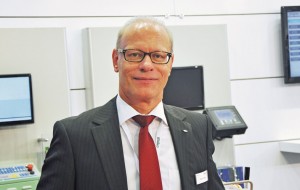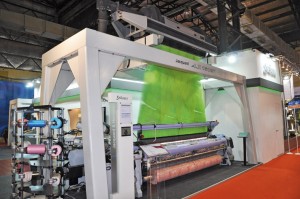Staubli has always led the weaving industry in terms of technological innovations. Be it the dobbies, jacquards or warp prepartory  machines, Staubli has continuously worked on further improving the productivity and performance of its machines. All these efforts have resulted in further increasing its engagement with its customer and increasing its marketshare. In a recent interview, Mr. Fritz LEGLER, Vice President – Product Management and Marketing, spoke about the company’s performance in 2013 and its expectations for the future.
machines, Staubli has continuously worked on further improving the productivity and performance of its machines. All these efforts have resulted in further increasing its engagement with its customer and increasing its marketshare. In a recent interview, Mr. Fritz LEGLER, Vice President – Product Management and Marketing, spoke about the company’s performance in 2013 and its expectations for the future.
How was the year 2013 for Stäubli? What were the key highlights during the year?
The official figures for 2013 is not out yet but our own analysis and market intelligence suggest that the investment activity in key markets was much better than anticipated and far better than in 2012. Our standard shed forming technologies – dobbies and cam motions – were profiting from this trend. Furthermore, Stäubli increased its market share for Jacquard machines in key markets. Warp preparation technology with automatic drawing-in or beam knotting machines was in demand, and Stäubli’s benefits over alternative solutions were clearly seen. Our other brands, e.g., Schönherr for solutions in carpet weaving or Deimo for electronic controllers, were also gaining strength in their respective markets.
 Highlights in 2013 were certainly the market introductions of our latest dobby generation – S3000/S3200 Series – or our new cam motions – 1671/1681/1781 Series. Our new Jacquard machines SX are gaining market share as are our drawing-in machines of the DELTA & SAFIR lines or our famous TOPMATIC beam knotting machines. Moreover, our new carpet weaving machine, Schönherr ALPHA 500, is attracting a lot of interest. Our existing as well as prospective customers appreciate the innovative drive of our company.
Highlights in 2013 were certainly the market introductions of our latest dobby generation – S3000/S3200 Series – or our new cam motions – 1671/1681/1781 Series. Our new Jacquard machines SX are gaining market share as are our drawing-in machines of the DELTA & SAFIR lines or our famous TOPMATIC beam knotting machines. Moreover, our new carpet weaving machine, Schönherr ALPHA 500, is attracting a lot of interest. Our existing as well as prospective customers appreciate the innovative drive of our company.
Which were the global markets which did well during 2013, and how did Stäubli perform in these markets?
Besides India there were the usual claimants and leading markets which contributed to an improved market environment. Countries like China, Turkey, Pakistan or Bangladesh held their own but also, for instance, Italy did rather well in certain market areas. Stäubli was in a position to profit from this situation.
How was the Indian weaving market in general in 2013, and how was Stäubli’s performance during this period?
There was quite a bit of enthusiasm right after India-ITME held in December 2012 which gave the weaving industry some impetus.  However, some of the planned and official support vehicles like, for instance, the TUFS, took longer to materialize. This delayed project financing propositions. Letter of credits were not readily available for some time. Moreover, later into the year announcements by the American FED to reduce or taper industry support provided through what they call quantitative easing (i.e., bond buying activity), FDI or investment moneys left India, which brought down the strength of the local currency. This in itself helped the Indian industry to boost garment, yarn or fabric exports. This increased utilization of plant in a positive way.
However, some of the planned and official support vehicles like, for instance, the TUFS, took longer to materialize. This delayed project financing propositions. Letter of credits were not readily available for some time. Moreover, later into the year announcements by the American FED to reduce or taper industry support provided through what they call quantitative easing (i.e., bond buying activity), FDI or investment moneys left India, which brought down the strength of the local currency. This in itself helped the Indian industry to boost garment, yarn or fabric exports. This increased utilization of plant in a positive way.
Stäubli managed to gain market share within its textile activities such as Jacquard machines or warp preparation activities (drawing-in or beam knotting machines).
Can you highlight some of the key innovations in products and technologies at Stäubli in recent years?
It is our guiding principle that we provide “fast moving technology” to our customers. This can only be achieved through high investment into R&D activities to bring about innovative solutions which firmly address our customers’ needs.
Recent innovations are now being introduced into India also. Some examples would be our latest generation of dobbies (S3000 and S3200 Series) and cam motions (1600 and 1700 Series). Stäubli’sdobbies of the 3rd generation enable weaving machine running speeds in excess of 1’000 rpm with, for instance, the S3260 version. Another example would be the SX-Jacquard machine which is favored by Indian weavers over alternative solutions. Our SX Jacquard machine is predominantly used in India in all common application fields such as upholstery, terry and so forth.
In the area of warp preparation, a typical example would be our latest generation of drawing-in machines of the SAFIR line which provides much higher productivity compared to manual drawing in.
Finally, our brand Schönherr offers the latest generation of carpet weaving machines of the ALPHA 500 Series. Far-reaching application know-how with its Multi Weft Selector (MWS) system, high density carpet weaving as well as its 5 meter machine, help increase the flexibility and investment security for our customers.
What are your expectations from 2014? Do you see any interesting global trends evolving which can drive business in the weaving segment?
This is about crystal ball gazing – istn’t it? There might be general trends like the reindustrialization move in the US or increasing cost structures in certain countries which help shift some of the value-adding in our global textile industry. Having said this, we cannot see drastic changes when it comes to our more specific weaving industry. Some of the hype seen in 2013 was probably to the detriment of the current year. There will almost certainly be a more reasonable or standard level of investment in 2014. Let’s keep our fingers crossed that there will not be, for instance, a global currency crisis as seen in the past.
With the Government’s push to modernize the Indian weaving segment, do you see good growth opportunity in this market?
There will be growth opportunities going forward. Stäubli welcomes any initiative supporting this idea and direction. However, sometimes the mills of India grind slowly – there is always a danger that there will be too much red tape involved! Time will tell if the next government will implement necessary structural changes.
Can you provide some update on the Indian operations, your sales office in India?
Due to the importance of the market, Stäubli has been active with its own Indian set-up since 1993. In 2012 we had moved to our new building – “the Stäubli House” – in Mumbai where we house our three divisions – Textile, Connector and Robotics. We keep steadily growing our local teams based on market demands. As an example, we are currently training two new Sales Engineers and four new Service Technicians in our textile division. Our local General Manager, Mr. S. Mahajan, keeps feeling the pulse of the local industry and plans resources accordingly. Local staff will also be properly trained at our European production units to fully immerse in our innovations and fast moving technology.
In summary, we have full-fledged operation in India with a current strength of 27 members in our Textile Division, three in Sales and 20 in Service support backed with a showroom/demonstration center along with machines to offer training to our customers here at Mumbai.